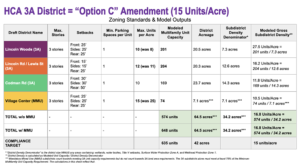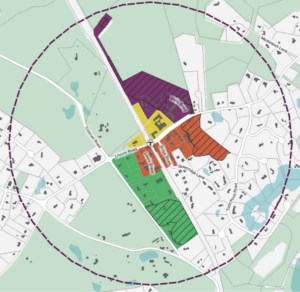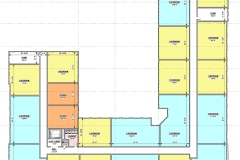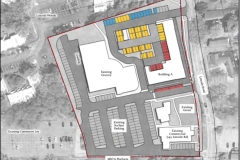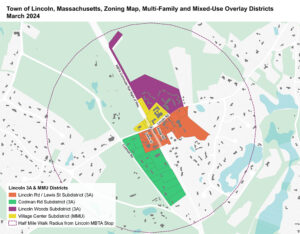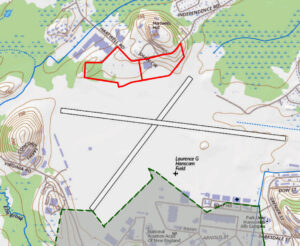Editor’s note: The Mass. Secretary of Energy and Environmental Affairs (EEA) issued a ruling on June 24 saying that the Draft Environmental Impact Report for the Hanscom Field expansion project “does not adequately and properly comply” with Massachusetts Environmental Policy Act Office (MEPA) regulations. Five Massachusetts state representatives also sent a letter on June 14 criticizing “this profoundly flawed DEIR.” For more coverage of the latest development on this issue, see the June 24 articles in the Bedford Citizen and the Concord Bridge.
By Christopher Eliot
The June 21 MEPA determination that the North Airfield Draft Environmental Impact Report (DEIR) is “not adequate” was very good news but is not the end of the story. Our next step is to write letters by August 13 to dispute the most recent Environmental Status and Planning Report and prevent the introduction of planning assumptions that can be used to justify the next version of the DEIR.
Some background: every five years, Massport publishes an Environmental Status and Planning Report (ESPR) that defines the planning assumptions for a five-year period. The ESPR is distinct from the DEIR, but the two are closely linked. The recently rejected DEIR was based on the 2017 ESPR, but the 2022 Hanscom ESPR has been written and is now open for review. (Writing an ESPR takes two years, so the publication date is two years after the reporting date.)
The 2022 Hanscom ESPR is closely linked with the proposed North Airfield hangar project and will be used in the next version of the DEIR to justify the project. We need to write letters disputing assertions in the ESPR that will be used to justify the future supplemental DEIR. Public comments can make a difference, and you are encouraged to write another letter to MEPA on this subject.
Much of the ESPR provides good factual data, but there are three major problems with the ESPR that need to be corrected:
1. Chapter 3 of the ESPR reports historical and projected airport activity levels through 2040 including a compound grown in business jet operations of 1.2%. This is incompatible with the climate crisis. It may be a valid projection of historical growth rates but we need to reverse the growth of private jet usage. Our local legislators understand this issue and are prepared to help. The ESPR needs to reflect the fact that sane public environmental policy will reverse the growth of private jets use, eliminating the need for new hangars.
Chapter 3 also fails to discuss likely scenarios for the introduction of eVOTL (electric vertical take-off and landing aircraft), eCTOL (electric conventional take-off and landing aircraft), and advanced air mobility aircraft (AAM). These new technologies might be an improvement or might have scary implications for residents near Hanscom airport; I don’t know because Massport has not said anything about their plans. This needs to be fixed. This technology is already being deployed in some parts of the world and should be discussed.
2. Chapter 7 reports on noise issues but fails to account for recent research showing that noise is a public health problem. It has been scientifically demonstrated that noise leads to systemic inflammation and causes increased mortality due to heart disease as well as learning problems and mental illness. The ESPR chapter incorrectly minimizes all of these problems and needs to be fixed.
3. Chapter 8 includes problematic descriptions of improved aviation fuels:
First, the ESPR incorrectly states that unleaded aviation fuel is not yet available. “As of writing, it is still unknown exactly when 100UL [fuel] will become a readily available resource at all airports” (page 8-37). This is not true: the fuel can be sourced from Vitol Corp. I called this company and verified that they are able and willing to deliver this unleaded aviation fuel to Hanscom Field as soon as they get a purchase order.
Second, in section 8.6.5 starting on page 8-38, there is a discussion of sustainable aviation fuel (SAF) at Hanscom Field. The discussion regurgitates industry propaganda about SAF that is easily refuted. The Government Accountability Office published a report last year that disputes many of these claims. More recently, Chuck Collins et al published a report titled “Greenwashing the Skies” that provided a detailed explanation of the problems with SAF as a solution to the climate problem of aviation. While industry wants us to believe this is a solution that just needs to be deployed, there are many fundamental issues in the way, and it is very unlikely that the promise of SAF will ever be fulfilled. In the meantime, industry uses the false promise of SAF as an excuse to avoid any meaningful response to their contribution to the climate crisis. There are a number of better proposals to mitigate aviation’s contribution to the climate crisis, so it is important not to allow the industry to pursue the distraction of SAF for the next 10 or 20 years.
The ESPR is extremely important in the debate over the North Airfield project because the ESPR is the planning document used to justify the North Airfield project. We should ask MEPA to require corrections to the ESPR while the comment period is open until August 13, 2024. Changing the ESPR to make more realistic assumptions about how community response can limit the growth of private jet travel will remove the primary justification for the North Airfield project. The developers are now required to write a supplemental DEIR based on the 2022 EPSR as a foundation.
As written, the 2022 ESPR provides a pillar of support for the project; your letters can help convert it into a pit of quicksand.
Comments on the 2022 ESPR should be sent to the same place as comments on the DEIR but should reference “Project 2022 L.G. Hanscom Field Environmental Status and Planning Report (2022 ESPR) (EEA #5484/8696)”:
Secretary Rebecca Tepper
Executive Office of Energy and Environmental Affairs
Attn: MEPA Office
Alex Strysky, EEA No. 5484/8696
100 Cambridge St., Suite 900
Boston, MA 02114
“My Turn” is a forum for readers to offer their letters to the editor or views on any subject of interest to other Lincolnites. Submissions must be signed with the writer’s name and street address and sent via email to lincolnsquirrelnews@gmail.com. Items will be edited for punctuation, spelling, style, etc., and will be published at the discretion of the editor. Submissions containing personal attacks, errors of fact, or other inappropriate material will not be published.
Eliot is chair and Lincoln’s representative to the Hanscom Field Advisory Commission.




